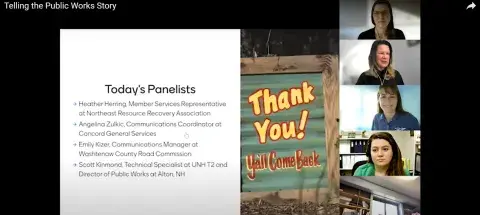
What does it mean to tell your local Public Works story? Marilee LaFond, Director of Technology Transfer Center at UNH gathered a panel of speakers to explore storytelling at their latest virtual discussion on May 19, 2021.
Why does storytelling in Public Works matter? In the past, Public Works have done their work quietly and hoped that the public was satisfied with the results. Resident’s expectations have changed today, and they want more communication about local projects. Public Works need to explain what they do and why it is important. They need to show residents that Public Works is making progress and not “just standing around looking into a hole.” Scott Kinmond, Director of Public Works in Alton, NH, said that he needs to “answer questions about dust from gravel roads to residents new to NH every year.” He reassures residents that, “the road gets graded four times a year.”
Heather Herring, Member Services Representative from NRRA, shared examples of how NRRA uses data, including story maps, annual reports, and a pilot program to broadcast our message. Once NRRA gathered their glass program data in one report, we realized we were serving over 500,000 residents with two different glass programs. We hired the GIS lab at Antioch New England Graduate School to create a story map that involves moving maps, videos, and stories about the process and product. “The story map helps members and staff visualize the programs and answer questions from communities considering what to do with their glass.” NRRA uses technology to network its members, but also remember that simple storytelling from an experienced recycling facility operator can hush a room as well. That’s why we highlight stories from members in our annual reports and at monthly member meetings. Along with visuals showing the benefits of membership, tonnages of recyclables and solid waste that NRRA members have moved, we also show photos of members at work and supportive quotes from members. NRRA is working with the City of Keene, NH on a pilot backyard composting program comparing two types of systems to divert waste and we plan to share this data with our members in the fall of 2021.
Emily Kizer, Communications Manager of the Washtenaw County Road Commission (WCRC), highlighted ways their independent Ann Arbor area organization communicates with their 350,000 residents in the county and 80,000 residents outside of city limits. They are in charge of 1,600 miles of county roads so they have utilized the WCRC Fit-It app as a way for people to report a road issue from potholes to signal problems. There is an online map on the website to highlight where the problem is located. They also send out weekly road advisories specific to the resident’s area on the website and residents can sign up to receive email updates. The WCRC has an interactive project map to show what is going on in the county during construction season and share lots of photos of the project’s progress. It is important to also update the public when and why there is a delay. WCRC has a FAQ section to help residents where they show a “life of a road” and when they do what kinds of repairs. WCRC uses social media to bring one core message to share with different audiences. WCRC does respond to residents’ comments on social media to better explain projects. Residents just want to know they haven’t been forgotten.
Angelina Zulkic, Communication Director of Concord General Services (CGS), includes videos and online campaigns to get its Public Works messages across to the public. They work with roads, utilities, water, sewer, stormwater, administration, municipal solid waste, utilities, water treatment, and public property buildings. Their website uses the MyConcordNH app for residents to report a problem. Concord usually offers community programs such as Touch a truck, a water conservation exhibit, virtual sewer pipe tours, a recycling relay to find out what is recyclable, and a famous battle of the backhoe. The Public Works staff enjoys the competition every year. Due to the pandemic, this year’s National Public Works Week was held virtually, including a contest to name the PW Mascot. Residents can click on a map to tour the city through videos and activities. In May, they also held a Virtual Drinking Water Festival geared toward teachers, parents, and students. CGS raffles off some Pay As You Throw trash bags when residents subscribe to their newsletter. Public Works are usually in the shadows and you don’t hear from residents unless something has gone wrong. CGS also provides a way for residents to reflect on their services by asking residents to submit a thank you note. The staff appreciates the positive feedback on the Facebook page, like appreciating clean drinking water or fixing the pothole.
The panel and participants had a lively discussion about how best to inform the public. Rumors are costly and it is best to get the facts from the source. Public Works communicates its messages for the safety of its staff and the public.
In case you missed the panel and are looking for ideas on how to communicate your Public Works story, it was recorded. UNH T2 offers other education workshops for the transportation workforce.
